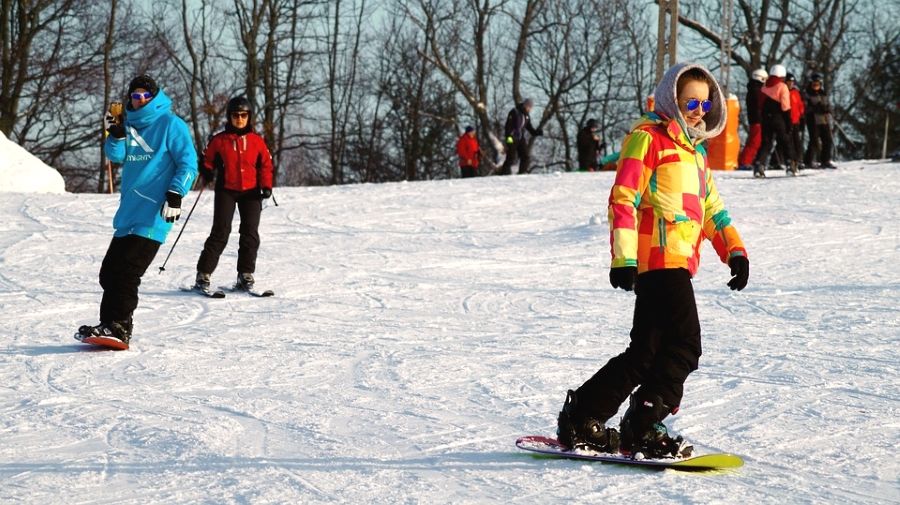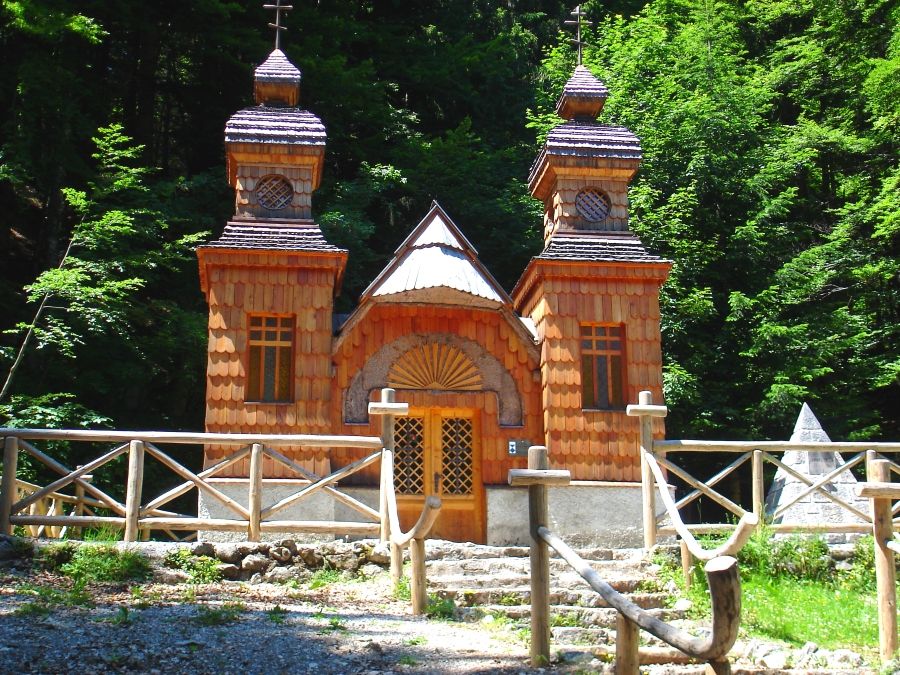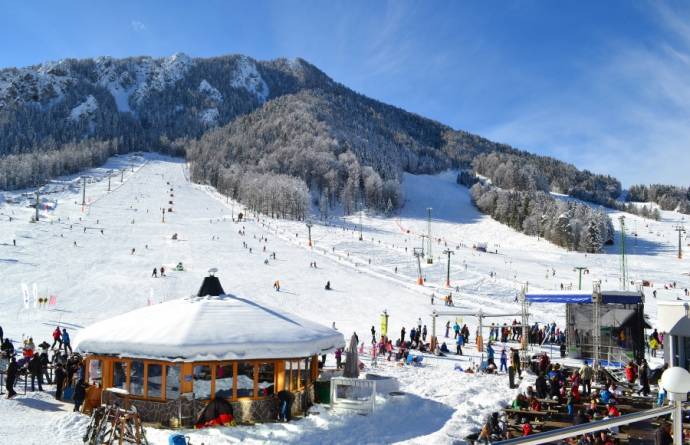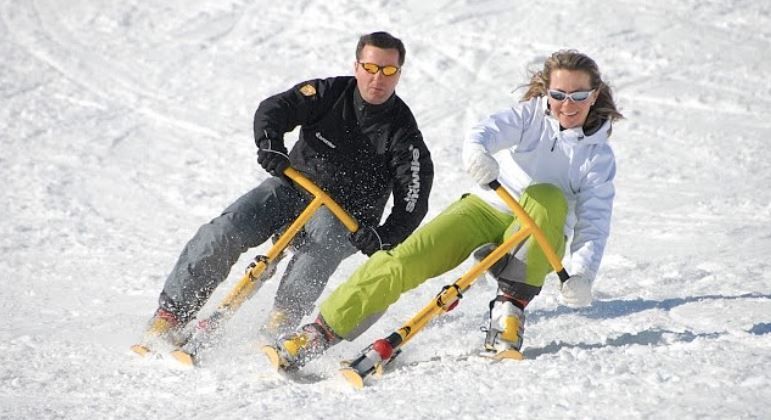While a trip to Kranjska Gora offers breath-taking views and a wealth of outdoor activities all year round, it’s in winter that the area’s most beautiful, and that the town’s snow centre comes to life, with many of the activities based in or around Snow Park Kranjska Gora, one of the biggest and most popular ski resorts in the country.
The resort has something for all ages and abilities, as well as a café with good views of the action if you prefer to stay warm and watch others fly down the slopes or fall on their behinds. A live webcam showing the current state of the slopes is below.
Other webcams of the area can be found here, while the price list for various activities is here.
The park has 18 slopes with varying degrees of challenge, as well as chairlifts, drag lifts, instructors, guides and equipment for rent. A great map of the various facilities can be found here.
Visitors with enough stamina may enjoy the 40km cross-country skiing trail that runs from Kranjska Gora to Sava Dolinka River and Planica (see below) into the Tamar Valley and in Gozd Martuljek. Those seeking to make less of a commitment can of course turn around and ski back to town at any point, or check out the trails at Mojstrana and in Zgornja Radovna. There’s also the option of cross-country skiing at night, which sets off from behind the Hotel Kompas in Kranjska Gora. I don’t ski, so the official map of the trails means very little to me, but if you know what you’re looking at then this might be useful.

Snowboards and skiers, living in harmony. Photo: Pixabay
Those who’d rather get off piste can engage in some ski touring, with trails from the gentle to extreme, and – as with all other activities on offer in Kranjska Gora – both equipment and guides can be hired
Where there are skis, there’ll be snowboards, and the Kranjska Gora snow park has all the equipment and facilities needed for complete beginners or people who can already pull of some tricks. More details can be found at the Kekec ski school site, which has lessons and courses for all ages and abilities.
If you can’t ski or snowboard and, like me, have no desire to learn, then you can always sit on a sled and cling on for dear life as you hurtle down one of the dedicated slopes. If even that seems too dangerous, then snowshoes can be rented so you can get off the road and explore the landscape, without fear of falling over or sinking into a snowdrift.
While the more adventurous may try and ice skate on the nearby Lake Jasna (see below), if you want to avoid any possibility of falling through the ice then I recommend the skating rink between the Ramada Resort Kranjska Gora and Kompas Hotel.
Seconds before a fall. Photo: kranjska-gora.si
Another activity, and one that’s entirely new to me, is snow biking. A snow bike is like a bicycle, with skis instead of wheels and no pedals. Instead, you just sit on the saddle and slide down a hill steering with a handle bar, along with short skis on your feet for added stability. The website promises “almost no injuries while cycling,” which is something that appeals to me strongly.
One might think that thick snow would mean standard wheeled cycling is out of the question, but with the aid of fatter tyres it’s possible to pedal over the winter terrain, with everything you need for this available at the Winter Bike Park Kranjska Gora, although only from 16:00 to 19:00 on Fridays and Saturdays. This can be found under the Kekec ski school site chair lift.
Given the stunning views it’s no surprise there are over 100km of hiking trails around the town, offering varying degrees of difficulty and length. A map of these can be obtained at the local tourist centre, although many of the centre’s maps can also be found online
If you prefer to watch the professionals do their thing, then the Vitranc Cup is held in Kranjska Gora each year, with a two-day program of slalom events. The website for the 2018 event, which will be on March 3 and 4, gives more details.
While Ljubljana only has its ‘Happy December’ stalls for one month, Kranjska Gora has an Alpine Village all winter, set up in the marketplace in front of the Church of the Assumption of the Virgin Mary. Here you can browse stalls selling handicrafts, food and drink, enjoying the atmosphere and music with a cup or three of mulled wine and a klobasa.
Finally, if all the action on the slopes doesn’t provide enough of a thrill, then there are also a number of casinos in the town where you can risk something other than a broken leg.
Just a few kilometres from Kranjska Gora is the ski-flying mecca of Planica. This is a place that’s synonymous with ski flying, which is ski jumping on bigger scale, with the main slope at this location – the Flying Hill of the Gorišek brothers – being partly responsible for the 28 world records set here, a record in itself. This slope is part of the Planica Nordic Centre complex, which also includes seven ski jumping hills of various sizes, as well as a cross country ski track and museum.
In the summer the Centre lets paying visitors feel some of the thrill and none of the danger of a world class ski flier, as they whiz down the world’s steepest zipline, one that’s 566m long and enables speeds of up to 90km/h. Going the other way, from the bottom to top, there’s the annual Red Bull 400 event, usually held in September and open to all who register, in which the strong-legged competitors get a full cardio workout by running 400 meters up the main slope.
Ansambel Saša avsenika, with the deathless "Planica, Planica"
The world class nature of Planica’s ski centre means that it hosts a lot of important competitions and events, such as the FIS Cross-Country World Cup and FIS Ski Jumping Continental Cup for Women (both January 20 and 21, 2018), the jewel of which is the annual FIS Ski Jumping World Cup, which in 2018 will be held March 22 to 25. Having attended in 2016, the year when the Slovene Peter Prevc won the world championship, I can say that this is a truly remarkable and somewhat overwhelming event, with daring athletes flying through the air at incredible speeds, heights and distances, all cheered on by thousands of good natured fans, waving flags, singing songs and drinking heavily, the hills alive with the sound of the Planica song, again and again and again.
Details of the full programme of events can be found here, while tickets – which tend to sell out early for the World Cup – can be purchased here.
One piece of advice if you do go to the World Cup: the walk back from Planica to your hotel in Kranjska Gora is a very long one that soon becomes cold and boring. I recommend waiting for a seat on the free buses instead.
Some attractions on the way to Kranjska Gora
Getting there and on the way
If driving from Ljubljana you can reach the town by following the route to Kranj, Jesenice, and then Kranjska Gora. It’s also possible to travel to Kranjska Gora by bus, and a bus also runs from the town to the nearest train station, about 20km away in Jesenice.
If coming by car then consider crossing the Vršič Pass, which is a picturesque, twisty turny road that’s the highest such pass in the Eastern Julian Alps, rising to a little over 1,600m. A drive across it will require some concentration and steady hands and feet on the controls, although in the worst weather it’s simply closed. It’s not the easiest site to navigate, but details of any closures – for Vršič and elsewhere in Slovenian, can be found here.

The Russian Chapel. Photo: Wikimedia
While driving this way you also have the chance to see the Russian Chapel, made of wood and built in 1916 to mark the deaths of the many Russian prisoners of war who died building the mountain road during World War 1, which is one reason why Putin made his flying visit there in 2016. The pass also gives you a view of the Prisank Window, a hole through the Julian Alps that’s 80m high and 40m wide. While it can be seen from the road, another option is to follow the path from Vršič towards the top of the Prisank Mountain.
Finally, a stop at Lake Jasna on the road to Kranjska Gora is always a joy, with crystal clear waters rimmed by a white, sandy shore. In the warmer months people swim here, and at any time of year there are paths and trails that make it easy to walk around the two artificial lakes that make up this scenic area, with fantastic views of the mountains. There’s also a tower by the lake that you can climb and get even better views from. In the winter the lake freezes over and ice-skating is possible, although there’s always the risk of falling through the ice so proceed with caution.








